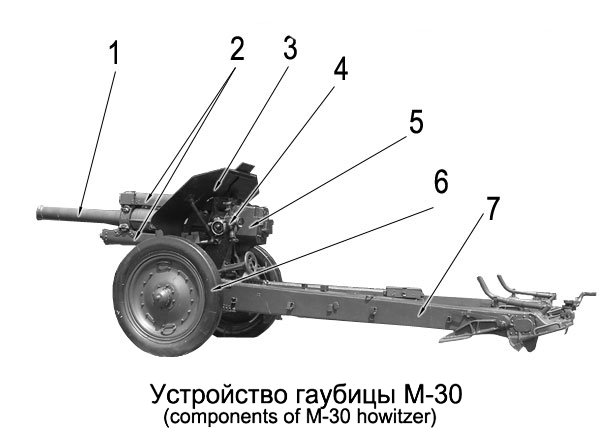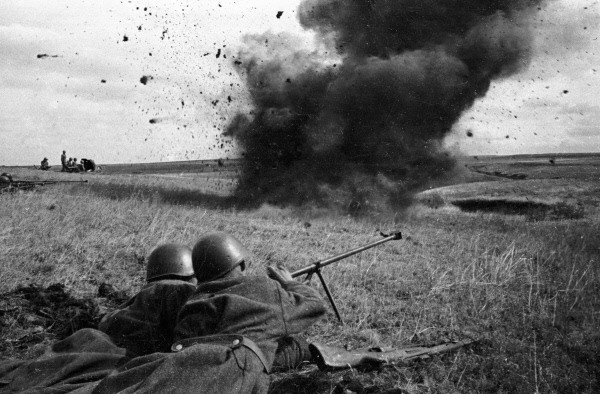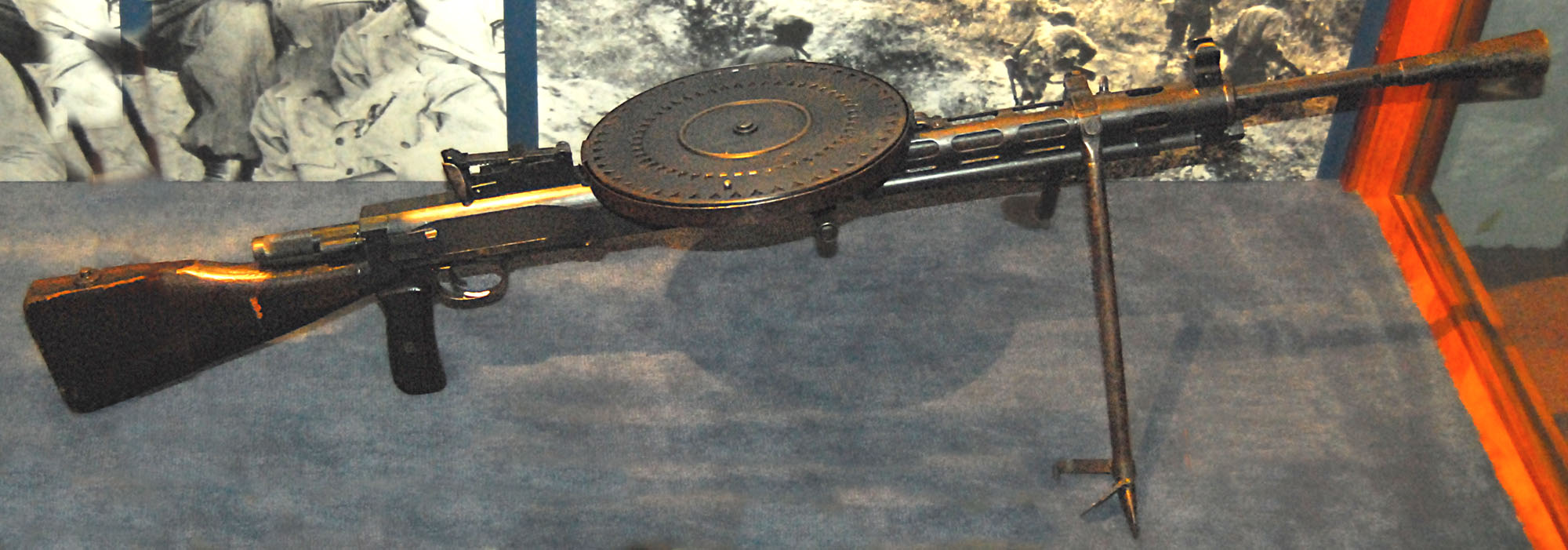|
43rd Guards Rifle Division
The 43rd Guards Rifle Division was an elite Latvian infantry division of the Red Army during World War II. The division was formed as an elite infantry division of the Red Army in October, 1942, based on the 1st formation of the 201st Rifle Division. The 201st was the only division made up of Latvian nationals in the Red Army until 1944, and the 43rd was immediately nicknamed the "Latvian Guards" division, which stuck through its existence. Formed in Northwestern Front, its initial service was in the dismal fighting around the Demyansk salient until that was evacuated by German Army Group North in February, 1943. Through the rest of the year it fought in that Front, mostly facing the several German strongpoints in the area of Velikiye Luki. Beginning in January, 1944 the division took part in the offensive that finally drove the German forces away from Leningrad and before the summer offensive, now in 22nd Army of 2nd Baltic Front it provided a cadre to form the 130th Latvian Rif ... [...More Info...] [...Related Items...] OR: [Wikipedia] [Google] [Baidu] |
Red Army
The Workers' and Peasants' Red Army (Russian: Рабо́че-крестья́нская Кра́сная армия),) often shortened to the Red Army, was the army and air force of the Russian Soviet Federative Socialist Republic and, after 1922, the Union of Soviet Socialist Republics. The army was established in January 1918. The Bolsheviks raised an army to oppose the military confederations (especially the various groups collectively known as the White Army) of their adversaries during the Russian Civil War. Starting in February 1946, the Red Army, along with the Soviet Navy, embodied the main component of the Soviet Armed Forces; taking the official name of "Soviet Army", until its dissolution in 1991. The Red Army provided the largest land force in the Allied victory in the European theatre of World War II, and its invasion of Manchuria assisted the unconditional surrender of Imperial Japan. During operations on the Eastern Front, it accounted for 75–80% of casual ... [...More Info...] [...Related Items...] OR: [Wikipedia] [Google] [Baidu] |
Riga
Riga (; lv, Rīga , liv, Rīgõ) is the capital and largest city of Latvia and is home to 605,802 inhabitants which is a third of Latvia's population. The city lies on the Gulf of Riga at the mouth of the Daugava river where it meets the Baltic Sea. Riga's territory covers and lies above sea level, on a flat and sandy plain. Riga was founded in 1201 and is a former Hanseatic League member. Riga's historical centre is a UNESCO World Heritage Site, noted for its Art Nouveau/Jugendstil architecture and 19th century wooden architecture. Riga was the European Capital of Culture in 2014, along with Umeå in Sweden. Riga hosted the 2006 NATO Summit, the Eurovision Song Contest 2003, the 2006 IIHF Men's World Ice Hockey Championships, 2013 World Women's Curling Championship and the 2021 IIHF World Championship. It is home to the European Union's office of European Regulators for Electronic Communications (BEREC). In 2017, it was named the European Region of Gastronomy. I ... [...More Info...] [...Related Items...] OR: [Wikipedia] [Google] [Baidu] |
Demyansk 1943
Demyansk (russian: Демя́нск) is an urban locality (a work settlement) and the administrative center of Demyansky District of Novgorod Oblast, Russia, located along the Yavon River. Municipally, it is incorporated as Demyanskoye Urban Settlement, the only urban settlement in the district. Population: History Demyansk was first mentioned in a chronicle in 1406 as Demon. The area was a part of Derevskaya Pyatina of Novgorod. Demon was a fortress protecting a waterway from Lake Ilmen upstream the Pola and the Yavon to Lake Seliger. The fortress was located close to the boundary between the Novgorod Republic and the Grand Duchy of Moscow, and it was at least twice sieged by Muscovite troops. In 1441, the Muscovites did not manage to conquer Demon, but in the 1470s they conquered and destroyed the fortress. After the subsequent fall of Novgorod, Demon was transferred to the Grand Duchy of Moscow. In the 17th century, Demon went into decline, and a new settlement was founded ... [...More Info...] [...Related Items...] OR: [Wikipedia] [Google] [Baidu] |
45 Mm Anti-tank Gun M1937 (53-K)
The 45 mm anti-tank gun model 1937 (factory designation 53-K, GRAU index 52-P-243-PP-1), nicknamed the Sorokapyatka (from Russian сорокапятка, or "little forty-five"), was a light quick-firing anti-tank gun used in the first stage of the German-Soviet War. It was created by Soviet artillery designer M.N. Loginov of Plant No. 8 (now Kalinin Machine-Building Plant) after the arrest and execution of former designer V. von Behring. Due to insufficient armor penetration it was replaced in service by the longer-barreled M-42 in 1942. Production of the gun ceased in 1943 with a total of 37,354 units built from 1937 to 1943. History The 53-K was essentially an improved version 19-K anti-tank gun mounted on a 37 mm 1-K anti-tank gun chassis (itself a licensed copy of the 3.7 cm Pak 36) using modern ammunition. Other improvements comprised semi-automatic breech, sight, firing button, suspension, reliable shield mount, and movable part re-balancing. The sum of evolutionar ... [...More Info...] [...Related Items...] OR: [Wikipedia] [Google] [Baidu] |
122 Mm Howitzer M1938 (M-30)
The 122 mm howitzer M1938 (M-30) (GRAU index: 52-G-463) was a Soviet 121.92 mm (4.8 inch) howitzer. The weapon was developed by the design bureau of Motovilikha Plants, headed by F. F. Petrov, in the late 1930s, and was in production from 1939 to 1955. The M-30 saw action in World War II, mainly as a divisional artillery piece of the Red Army (RKKA). Captured guns were also employed later in the conflict by the German Wehrmacht and the Finnish Army. Post World War II the M-30 saw combat in numerous conflicts of the mid- to late twentieth century in service of other countries' armies, notably in the Middle East. Development In 1930 Red Army (RKKA) authorities started to look for a new divisional-level howitzer to replace the pre-World War I 122 mm howitzer M1909 and 122 mm howitzer M1910. Although both pieces were eventually modernized, resulting in the 122-mm howitzer M1909/37 and the 122-mm howitzer M1910/30 respectively, these upgrades did not address some short ... [...More Info...] [...Related Items...] OR: [Wikipedia] [Google] [Baidu] |
PTRD-41
The PTRD-41 (Shortened from Russian, ''ProtivoTankovoye Ruzhyo Degtyaryova''; ''Противотанковое однозарядное ружьё системы Дегтярёва образца 1941 года''; "Degtyaryov Single Shot Anti-Tank Weapon System Model of 1941") was an anti-tank rifle produced and used from early 1941 by the Soviet Red Army during World War II. It was a single-shot weapon which fired a 14.5×114 mm round, which was able to penetrate German tanks such as the Panzer III and early models of the Panzer IV. Although unable to penetrate the frontal armor of late-war German tanks, it could penetrate their thinner side armor at close ranges as well as thinly armored self-propelled guns and half-tracks. History In 1939, in its invasion of Poland the USSR captured several hundred Polish Model 35 anti-tank rifles, which had proved effective against the German invasion of Poland from the West. Vasily Degtyaryov copied its lock and several features of the Ge ... [...More Info...] [...Related Items...] OR: [Wikipedia] [Google] [Baidu] |
82-BM-41
The 82-pm-41 (russian: 82-Полевой Миномёт-41), M-41 or the 82-mm mortar Model 1941 (russian: 82-мм миномет обр. 1941 г.) was a Soviet 82-millimeter calibre mortar developed during the Second World War as an infantry battalion mortar, and which began production in 1941. Design It differed from the Model 1937 by the presence of a removable wheel base, by the arched construction base plate (as in 107-mm and 120-mm mortars), and also a different two-legged construction. Wheels were slipped over the semi-axis of the bipod feet and removed during firing. Design improvements were made to reduce weight and production cost, and improve manoeuvrability. The ballistic data of the Model 1941 mortar were analogous to the Model 1937. The 82-mm mortar Model 1941 was more convenient to transport than the Model 1937, but was less steady during firing and had a worse centre of gravity. To correct shortcomings of the 82-mm mortar Model 1941 it was modernised durin ... [...More Info...] [...Related Items...] OR: [Wikipedia] [Google] [Baidu] |
M1938 Mortar
The 120-PM-38 or M1938 was a 120 mm Soviet mortar that was used in large numbers by the Red Army during World War II. Although a conventional design its combination of light weight, mobility, heavy firepower and range saw its features widely copied by successive generations of mortars. Design The origins of the M1938 lay in the French ''Mortier Brandt de 120mm Modele 1935'' and the Brandt mle 27/31 which the Soviet Union produced under license as the 82-PM-36. In 1937 the Soviets produced a modified version of the 82-PM-36 known as the 82-PM-37 and this mortar served as the pattern for the 120-PM-38. The main difference between the 82-PM-37 and the earlier 82-PM-36 was the adoption of a round base-plate, revised traverse/elevation controls, simplified sights and spring-loaded shock absorbers on the bi-pod to reduce the amount of relaying needed between shots. The 120-PM-38 is essentially a scaled up 82-PM-37 which uses the same two-wheeled limber as the 107 mm PBHM-38. The l ... [...More Info...] [...Related Items...] OR: [Wikipedia] [Google] [Baidu] |
PPSh-41
The PPSh-41 () is a Soviet submachine gun designed by Georgy Shpagin as a cheaper and simplified alternative to the PPD-40. A common Russian nickname for the weapon is "''papasha''" (), meaning "daddy", and it was sometimes called the "burp gun" because of its high fire-rate. The PPSh is a magazine-fed selective-fire submachine gun using an open bolt, blowback action. Made largely of stamped steel, it can be loaded with either a box or drum magazine and fires the 7.62×25mm Tokarev pistol round. The PPSh saw extensive combat use during World War II and the Korean War; in Eastern Bloc countries, monuments celebrating the actions of the Red Army commonly feature a PPSh-41. It became one of the major infantry weapons of the Soviet Armed Forces during World War II, with about six million PPSh-41s manufactured in this period, making it the most-produced submachine gun of the war. In the form of the Chinese Type 50 (licensed copy), it continued in use with the Viet Cong as late as 1 ... [...More Info...] [...Related Items...] OR: [Wikipedia] [Google] [Baidu] |
Degtyaryov Machine Gun
The Degtyaryov machine gun (russian: Пулемёт Дегтярёвa Пехотный, Pulemyot Degtyaryova Pekhotny literally: "Degtyaryov's infantry machine gun") or DP-27/DP-28 is a light machine gun firing the 7.62×54mmR cartridge that was primarily used by the Soviet Union, with service trials starting in 1927, followed by general deployment in 1928. Besides being the standard Soviet infantry light machine gun (LMG) during World War II, with various modifications it was used in aircraft as a flexible defensive weapon, and it equipped almost all Soviet tanks in WWII as either a flexible bow machine gun or a co-axial machine gun controlled by the gunner. It was improved in 1943 producing the DPM, but it was replaced in 1946 with the RP-46 which improved on the basic DP design by converting it to use belt feed. The DP machine gun was supplemented in the 1950s by the more modern RPD machine gun and entirely replaced in Soviet service by the general purpose PK machine gun in t ... [...More Info...] [...Related Items...] OR: [Wikipedia] [Google] [Baidu] |
PM M1910
The Pulemyot Maxima PM1910 (PM M1910) (Russian: Пулемёт Максима образца 1910 года, ''Pulemyot Maxima obraztsa 1910 goda'' – "Maxim's machine gun Model 1910") is a Heavy machine gun that was used by the Imperial Russian Army during World War I and the Red Army during the Russian Civil War and World War II. Later the gun saw service in the Korean War, the Vietnam War and the 2022 Russian invasion of Ukraine. History It was adopted in August 1910 and was derived from Hiram Maxim's Maxim gun, chambered for the standard Russian 7.62×54mmR rifle cartridge. The M1910 was mounted on a wheeled mount with a gun shield. In 1918–1920, the industry of Soviet Russia produced 21 thousand new Maxim 1910 machine guns for the Red Army.Пулемёты // Гражданская война и военная интервенция в СССР. Энциклопедия / редколл., гл. ред. С. С. Хромов. — 2-е изд. — М., «Советская э� ... [...More Info...] [...Related Items...] OR: [Wikipedia] [Google] [Baidu] |
II Army Corps (Wehrmacht)
II Army Corps (II. Armeekorps) was a corps in the German Army during World War II. Organisation Organisation of the corps at different times included; 1939 (September) * Corps Staff and Headquarters **402nd Corps Signals Unit **42nd Corps Propaganda Battalion ** 402nd Corps Supply Troops ** 402nd Field Gendarmerie Troop * 3rd Infantry Division * 32nd Infantry Division * 2nd Artillery Command 1940 (May) * Corps Headquarters ** 42nd Corps Signal Battalion ** 402nd Corps Mapping Platoon ** 402nd Courier Platoon ** 402nd Field Post Platoon ** 402nd Supply Battalion ** 402nd Military Police Platoon ** 1st Heavy Reconnaissance Flight, 11th Reconnaissance Squadron (attached from Luftwaffe) ** 3rd Heavy Reconnaissance Flight, 21st Reconnaissance Squadron (attached from Luftwaffe) ** 1st Battalion, 13th Anti-Aircraft Regiment (attached from Luftwaffe) ** 86th Light Anti-Aircraft Battalion (attached from Luftwaffe) * 7th Panzer Division * 12th Infantry Division * 32nd Infant ... [...More Info...] [...Related Items...] OR: [Wikipedia] [Google] [Baidu] |






